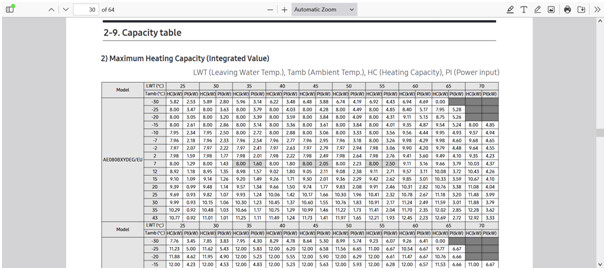Hi Umesh,
(Wikipedia: “(MVP) is a version of a product with just enough features to be usable”) Yup, that sounds like me…
When it comes to selecting a heat pump, YMMV (to quote our Leader), depending upon your expectations and requirements, and the relevance of the information available to you for making a decision:
- I only have direct experience with the HTQ Series. For a wider perspective on comparative heat pump performance, I would refer you to our CNCc (Chief Number Crunchers) @TrystanLea and @Timbones – few manufacturers have evaded their incisive scrutiny.
- HTQs are unusual in that they feature a 2-stage compressor (vapour injection circuit), so any observations I make on controller algorithms may not be relevant to Gen 7s (which I think are single-stage compression).
- I’m pretty confident that Samsungs (at least HTQs) will achieve at least nameplate heat duty over the full operating window. A quick glance at the (8kW HTQ) published window…
…shows that Samsung expect at least 8kW at all LWTs and ambient temperatures (apart from below -25degC). Why am I confident? Well 1) the same compressor is used in all HTQ units (8/12/14kW) so at the smaller end there is plenty of spare capacity under the bonnet, and 2) my measurements strongly suggest that this table applies just at synchronous compressor inverter frequency (50Hz), whereas in reality the inverter is quite capable of over 55Hz if the controller requests it – I have often observed heat duties well over 10kW on my 8kW unit, including on cold days – see example below.
- Your selection of ASHP may partly depend on how you plan to operate it. Many owners strive for the best possible CoP, and run “low and slow” (compressor trundling along at low speed 24h/day at the lowest LWT consistent with a warm house). Others (like me) look for the minimum operating cost. In my case this seems to be switching the heat pump off for 10h/day (using a large setback), and tolerating a high energy use for an hour or so each morning as the whole system warms up again. I’ve concluded that this is partly down to reduced night-time heat loss, and partly down to compressor efficiency – in my case the BEP occurs at or close to synchronous inverter frequency, and falls off quite significantly at lower compressor speeds, so by running my HTQ flat out for 1-2 hours or two I get a lower energy consumption than running it at 50% speed for 3-4 hours (whilst obtaining the same energy of course).
- Unfortunately, so far as I know, none of the heat pump manufacturers publish their compressor performance curves (i.e. head versus throughput for several speeds), so the only way of establishing optimum economics is to reverse engineer them (which is tricky without Outdoor Unit monitoring), or trying different operating strategies and watching what happens at your electricity meter.
- I can answer your question about heat output on cold days with a good recent example (10/01/25, when ambient was -5degC min overnight, 0degC max daytime, fairly high humidity – that’s about as bad as it gets, here in balmy Wiltshire). The maximum HTQ output I recorded was 10.6kW when ambient was -2degC, LWT was 47degC, inverter frequency 51Hz, Outdoor Unit power consumption approx 2.7kW). At these temperatures, the Capacity Table above shows 8.0kW duty, 2.8kW energy required, so I seem to have beaten that by some margin. My total household electrical consumption that day (and that’s including electric cooking, appliances, lighting etc., and a defrost cycle – something I rarely see on the HTQ thanks to its economiser circuit) was 34.2kWh – about £7 at my standard tariff. If that’s the worst day of the year, then that’s something I can live with. (It also suggests that it would be difficult to justify much in the way of @glyn.hudson 's OEM kit…)
- As to background power consumption, apart from the evaporator fan (around 100W) and circulating pump(s) (maybe 70W each), my Outdoor Unit monitor has entries for (compressor) base heater (which @Jakey notes is 200W when active) and PHE heater (no data on this). I’ve never noticed these heaters showing as operating on the monitor display, but I don’t watch it all the time.
Things I like about the HTQ are:
- Wide range of robust and energy-minimising controller algorithms
- Flexible controller user inputs
- So far (20 months operation) flawless operation
- Approachable Samsung Technical Helpline (even if they are constrained from answering some questions probably due the Head Office concerns for their technical assets)
Things I’d worry about:
- Operating manuals are hard to understand/interpret without lots of effort
- One or two problematic algorithms (like the one that swipes energy from your DHW tank for hourly frost prevention cycles when it’s cold, and the one that only allows the same DHW times every day, even if you only want to heat DHW 2-3 times each week)
- Other makers publish lots more operating data than Samsung
- Small user base, so lots more forum expertise with other makes
In summary, if you do go for a Samsung, and if (like me) you are cursed with an enquiring mind, you should be prepared to sometimes feel like the man who, with eyes tight closed and fingers in his ears, is gingerly stepping across a minefield…
